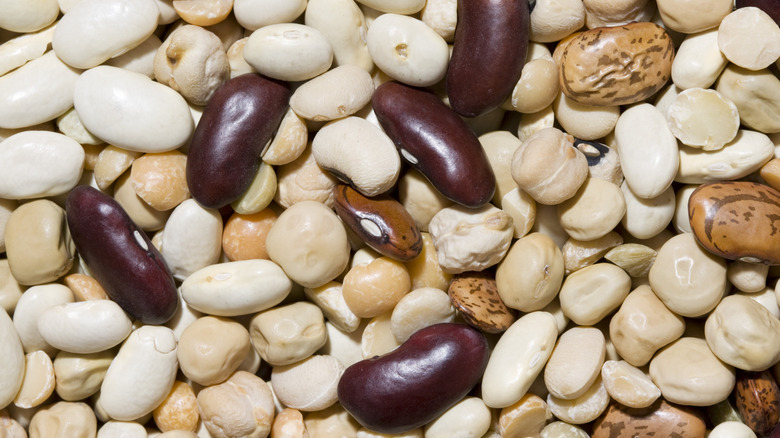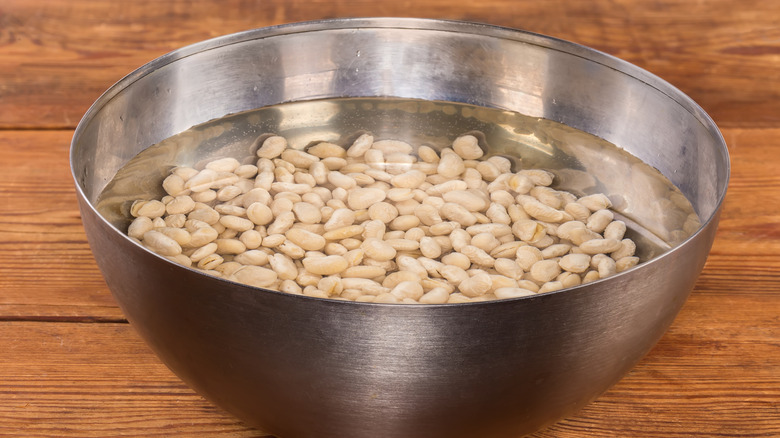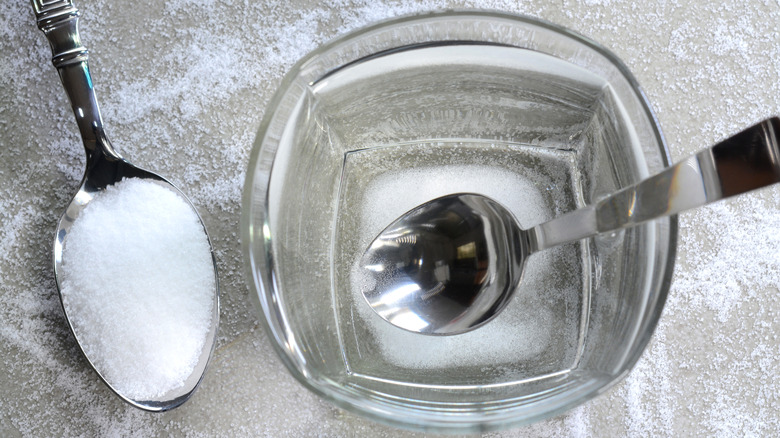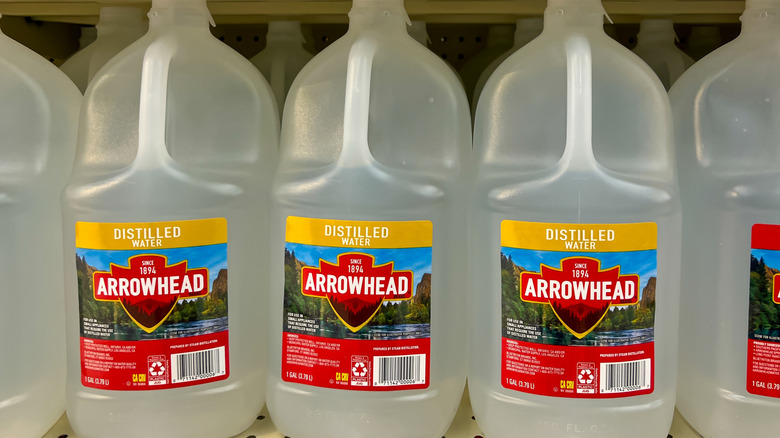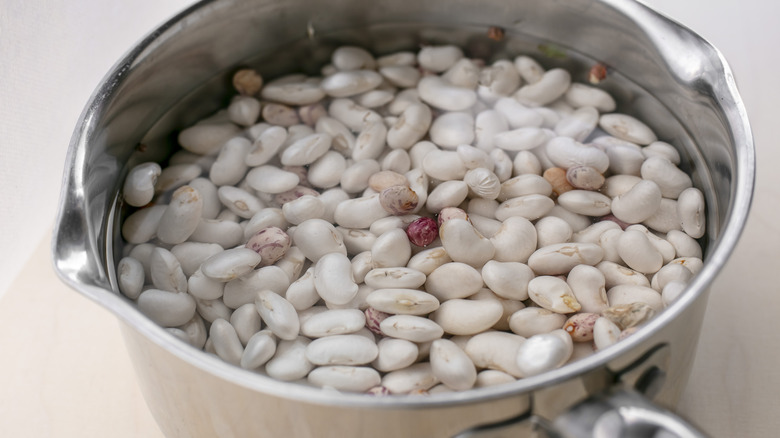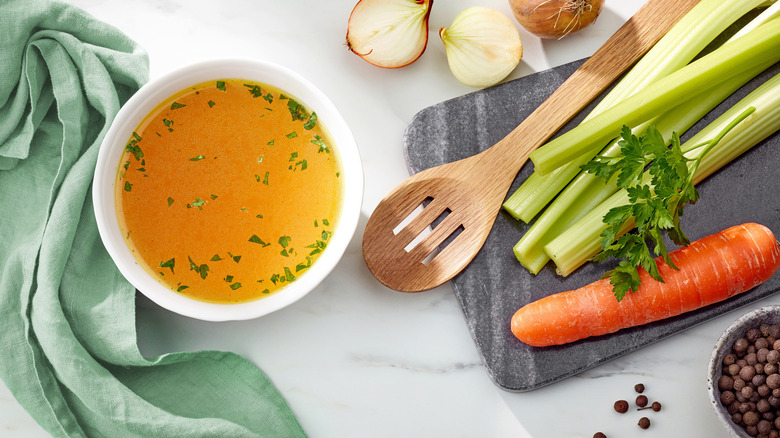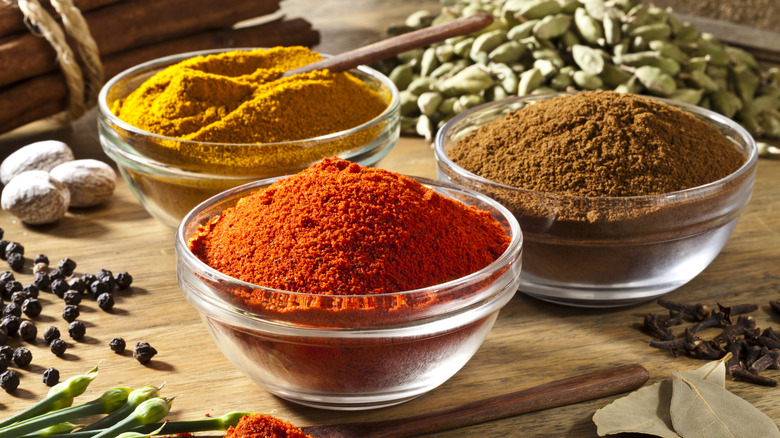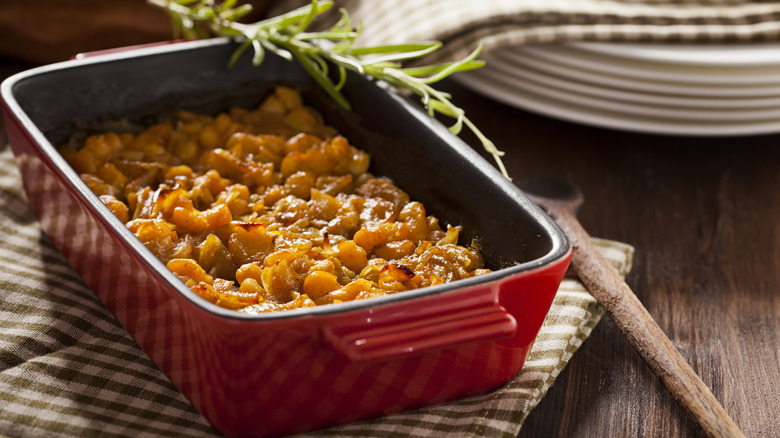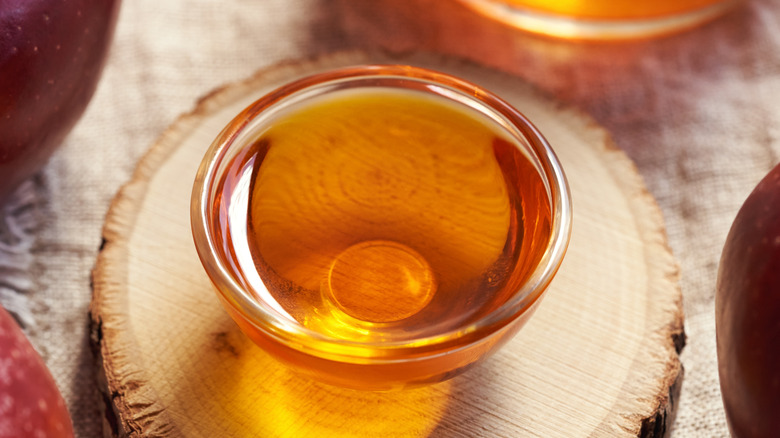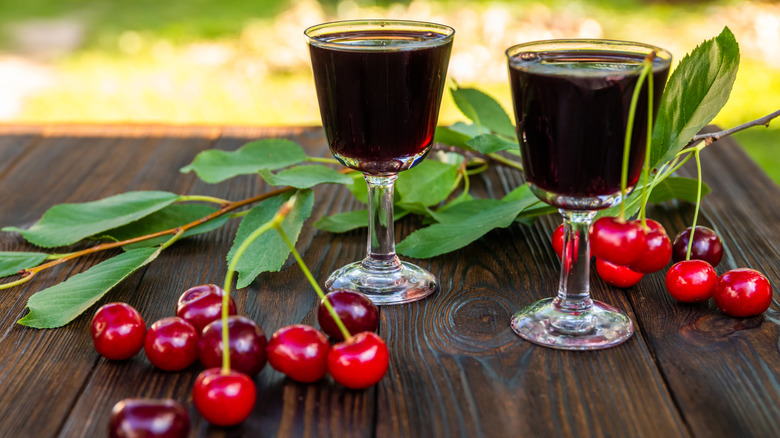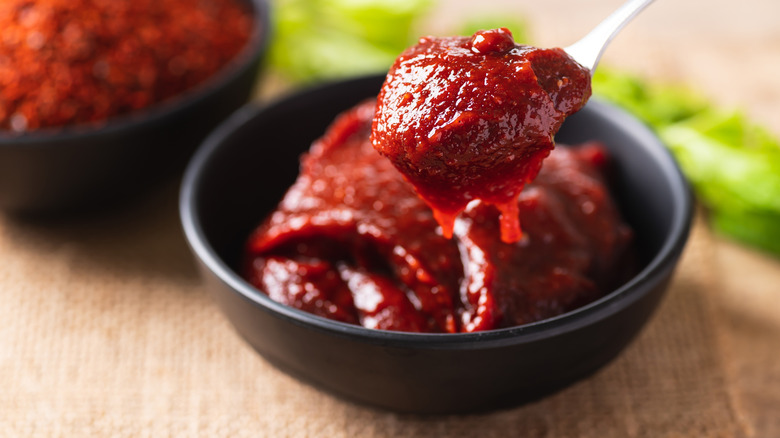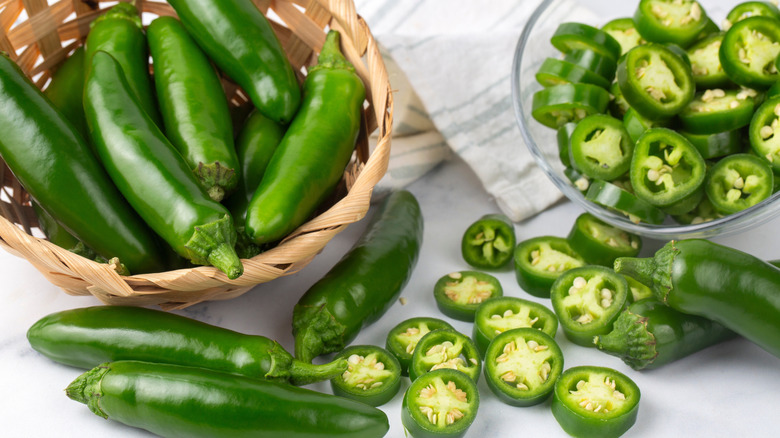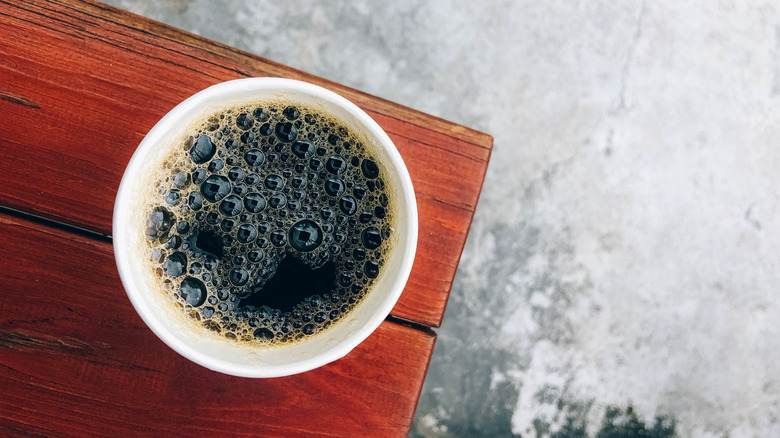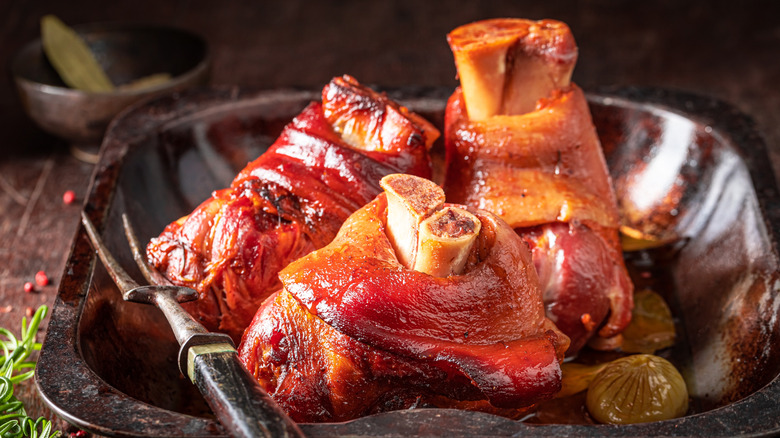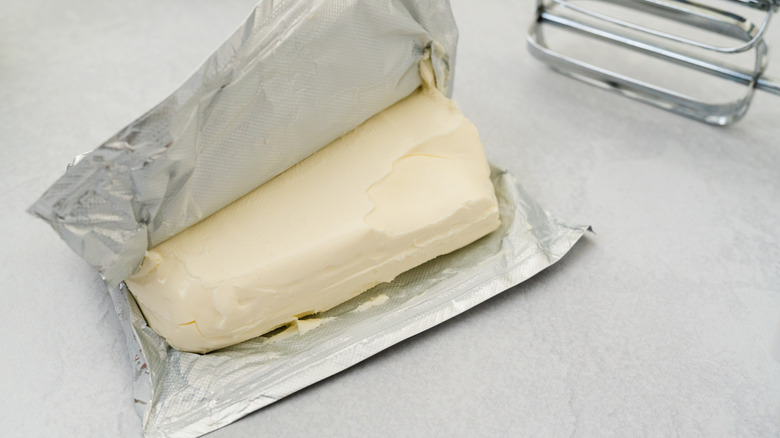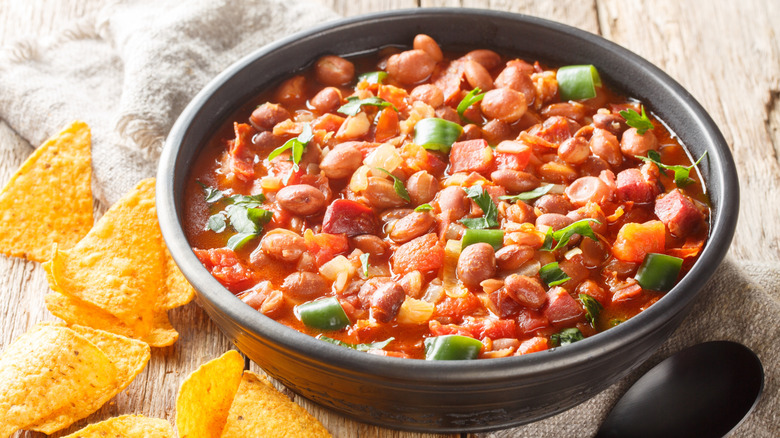17 Big Mistakes You're Probably Making With Baked Beans
Few dishes are as all-American as a piping hot pot of baked beans. This sweet and savory summer cookout staple has been filling tummies since the first European settlers were introduced to them by Native Americans. The most iconic variation on this classic is the flavorful, molasses-laden recipe for Boston Baked Beans. While they appear easy enough to make, if you've ever tried to cook a pot of these from scratch, you likely have run into some hiccups that rendered the dish less than mouthwatering.
That's where some professional advice can come in handy. As a chef, I have some expert tips to help you avoid the biggest mistakes many people make when preparing baked beans. From the type of beans to use, to whether or not they should be soaked, I'll help you demystify these luscious legumes so your next batch becomes the star of your family barbecue, not just an afterthought.
1. Mistake: Using the wrong kind of beans
When it comes to baked beans, the kind of bean you use is crucial for not only obtaining the right flavor but the appropriate texture. Most recipes for baked beans are made using navy beans, though any thick-skinned bean would work, including kidney, cannellini, or Great Northern varieties. Thick-skinned beans are generally mild in flavor and have a denser hull, which prevents them from splitting during the cooking process. When purchasing dried beans, you can find quality ones in bulk, like these Birch & Meadow Navy Beans available by the gallon. Regardless of where you buy them, make sure they are not too old, otherwise they will not cook properly.
Though you can use canned beans, dried beans are cheaper and will ultimately taste better as they have the opportunity to slow cook in the seasonings, allowing for the flavor to be absorbed. If you do opt to use canned beans, make sure you drain and rinse them properly to eliminate excess salt.
2. Mistake: Failing to soak the beans
Though the necessity of soaking beans is somewhat contested, many swear by the process, asserting that doing so will not only shorten the cooking time, but might make them easier to digest. This is particularly useful when cooking with thick-skinned beans or those past their prime. That said, if you're pressed for time, you can skip the soaking altogether or opt for what is known as a quick-soak versus an overnight soak.
Generally speaking, beans are soaked in cold water for anywhere from 4 to 24 hours, if placed in the refrigerator. To expedite things, you can quick-soak beans by boiling them in water for a few minutes and then allowing them to sit in the hot water for about an hour before cooking them. This will achieve similar results as a traditional soak in far less time. Before soaking beans using either method, make sure to clean them thoroughly in cold water to remove any impurities.
3. Mistake: Not salting the beans
Another commonly contested issue when it comes to cooking beans is the topic of whether you should salt them at the beginning of the cooking process or wait until they're fully cooked before doing so. The theory has always been that salting too soon can prevent the beans from thoroughly softening. New evidence suggests the contrary, however, according to the Culinary Research Team at RRC Polytech. Their research says that soaking the beans in a 2% salt brine prior to cooking them can reduce cooking time and produce a more even texture. This is particularly helpful with thick-skinned bean types and those that are past their prime.
Additionally, baking soda can be added to the brine to augment the salt. The baking soda will help to reduce the acidity of the brine, which in turn will further soften the skin of the beans, enabling them to cook more quickly without busting open.
4. Mistake: Using hard water
A common issue with preparing beans involves the water in which they are soaked and cooked. A majority of households in the US have exceedingly hard water that's loaded with calcium and magnesium. These minerals can dehydrate your skin and hair and leave a stubborn film on your appliances and bathroom fixtures that can be a pain to clean. They are also responsible for bolstering the pectin present in the cell walls of beans. This can create a barrier preventing the beans from absorbing liquid and softening, leaving them undercooked.
Though the best solution to this problem is to soak and cook beans in distilled water, this may not be practical or cost-effective. A better option is to soften water by passing it through a filter. There are some affordable and effective filters that do a great job of eliminating many of these minerals, like the Original Brita Large Water Filter Pitcher, which has a 10-cup capacity — more than enough to soak a batch of dry beans.
5. Mistake: Adding the wrong amount of liquid to the pot
The amount of liquid you use to both brine and cook beans is a further consideration. When brining beans, you want to cover them with enough water to submerge them and leave 1 to 2 inches of excess, which will allow them to swell as they soak without absorbing all the liquid and going dry. Before cooking the beans, drain them to remove the brine and cover them with fresh liquid.
The cooking liquid should be ample enough to cover the beans by 2 to 3 inches, allowing for them to swell as they soften while leaving enough liquid behind to make the dish saucy. You never want baked beans to be super thick. They should have the consistency of a thin gravy — velvety, but not gummy. A good rule of thumb to follow is to use 3 cups of liquid per cup of beans, or roughly 10 cups per pound.
6. Mistake: Not using alternative cooking liquids
Speaking of liquid, though water is the gold standard, there are plenty of other options that can completely transform the flavor of baked beans. At a bare minimum you may want to swap the water out with either vegetable or chicken stock or broth. You can use either, though the flavor of stock will be more intense because it has the added gelatin and protein from the collagen released by the chicken bones. Whichever you choose, make sure you opt for a low or no sodium variety, like Pacific Foods Organic Unsalted Chicken Stock, to ensure you don't over-salt the beans.
Other liquid options for cooking baked beans include coconut water, beer, wine, or dashi. When incorporating beer or wine, use it to supplement the water or other liquid, not on its own, otherwise it can be too overpowering. You may also want to boil it for a few minutes to reduce the amount of alcohol and enhance the flavor.
7. Mistake: Underseasoning your beans
A great way to spice up a batch of baked beans is to use some actual spices. Beans tend to have a relatively mild, bland flavor without the help of seasonings, such as aromatics and dried or fresh herbs. At the very least, you'll want to add a little salt and pepper to taste, but don't stop there. Many baked bean recipes include some heat in the form of dried mustard, smoked paprika, cumin, or chili powder, or a combination thereof.
When using spices, it doesn't pay to be too conservative with them. Though you don't want to be overly heavy-handed, you need not be shy. You want enough to flavor the cooking liquid adequately so that you know exactly what the taste of the beans will be as they absorb it. And, don't forget to toast the spices before adding the beans and liquid to the pot. Doing so can help maximize their flavor and aroma, enhancing the final dish.
8. Mistake: Not cooking them low and slow
Baked beans are not what you would call "fast food." The best baked beans are cooked low and slow for the perfect texture, and there's no good way to expedite this process short of a pressure cooker, which doesn't always yield the results. I prefer to prepare mine either on the stovetop or in the oven, where the beans can simmer, uncovered, allowing them to soften and the sauce to thicken slightly as the liquid slowly evaporates.
One possible alternative may be the slow cooker, though this one has some potential downfalls. The slow cooker may be a hands-off approach to making baked beans, but it's worth noting that you have to be even more cautious with the amount of liquid added. There's no way for the liquid to cook off, which may leave you with soupy, rather than saucy, baked beans. Also, be mindful not to over or undercook the beans. They should be just tender but still hold their shape. If they cook too long, they can fall apart, leaving you with something resembling refried beans.
9. Mistake: Adding acidity too early
One of the hallmark features of a quality baked bean recipe is the balance between sweet and savory. The best way to achieve this balance is through the addition of some acidity, which can enhance both elements. Ingredients like apple cider vinegar, lemon juice, or tomatoes can elevate the complexity of baked beans, making them more sophisticated and brightening them.
The key is not adding the acidity until the end of the cooking process. When added too early, the acid can fortify the pectin within the skin of the beans. This means no amount of cooking will help them to soften, even if you soaked them in a salt brine before putting them on the stove. Wait to add the acidic ingredient until the beans are just al dente, about 10 minutes before the dish is done. It is always a good idea to sample at least five beans to ensure that they are evenly cooked before determining doneness and moving forward with the addition of the acid.
10. Mistake: Only using molasses to sweeten them
If you have ever eaten a batch of Boston-style baked beans, you will notice a distinctive, rich, caramel-forward sweetness, which comes from molasses. While molasses was abundant in the 18th century, due to the rum trade, it is by no means the only sweetener you can use to give baked beans that sweet and savory flavor profile.
Other sweeteners that may confer complexity to your baked beans include dark brown sugar, maple syrup, agave, or honey. You can also sweeten it with fruit juice, but this requires a little finesse. Some fruits are too mellow, while others can quickly overwhelm the beans. The best candidates include darker fruits, which have a jammy quality that can counterbalance the acidity and spiciness of the baked beans. I recommend a splash of black cherry, like Lakewood Pure Black Cherry Juice, which has just the right balance of sweet and tart flavor notes.
11. Mistake: Not adding an umami-element
When it comes to baked beans, you might not expect the term umami to come into the discussion, but it plays a critical role in developing the flavor of a really great batch. Because complexity is the name of the game, using ingredients rich in umami-elements can help balance out the sweet, spicy, and acidic components of baked beans. Indeed, the word umami literally translates to "pleasant savory taste," reinforcing the integral part it can play in baked beans.
Among the common umami-rich ingredients added to baked beans are tomato paste, Worcestershire sauce, and Dijon mustard. Soy sauce and miso can also be used very effectively, though these are quite salty, so some care needs to be taken when adding them. If you're seeking to incorporate an umami-laden ingredient with a kick, look no further than the funky and fermented Korean condiment gochujang. For meaty umami notes without spice or acidity, I highly recommend sprinkling in some mushroom powder.
12. Mistake: Not adding some heat
Though dried spices, like smoked paprika and chili powder, can be used to add some heat to baked beans, if you really want to develop complexity, try tossing in some chili peppers, like jalapeños. This is an ingredient that celebrity chef Alton Brown swears by as the key to his version of baked beans. His recommendation is to add two seeded and chopped jalapeños per 1-pound batch of baked beans, though you can adjust this amount if you prefer more or less heat. Toss the jalapeños in with the aromatics at the beginning of the cooking process, before adding the beans and liquid. This will help to infuse the beans with the heat.
For a smoky variation, use chipotle peppers instead of jalapeños. If you're a chili head, you can always swap the jalapeños with something hotter, like cayenne or habanero peppers. Alternatively, if you want less heat, try substituting the jalapeños with subtler, earthy poblanos.
13. Mistake: Not adding a splash of coffee
With its bitter, nutty, and slightly acidic notes, brewed coffee can completely transform a batch of baked beans. Simply add some of the morning's undrunk cup of Joe into the recipe and watch how the beans develop an almost smoky quality that complements the sweet, savory, and spicy notes.
While any kind of coffee will do, this is not the place for a strong espresso. I recommend a light roast coffee from East Africa or the mountainous regions of Central America. These beans tend to be more acidic in nature, giving the baked beans a more complex flavor. Just remember, since acidity can prevent the beans from softening, you'll want to add the coffee toward the end of the cooking process. If you are not a regular coffee drinker, you can use instant coffee instead of brewed. A tablespoon added will dissolve into the hot beans quickly and easily.
14. Mistake: Not adding a boozy kick
There are a number of boozy ingredients that can enhance the taste of baked beans and take this comfort food into the realm of gourmet cuisine. One excellent alcoholic addition is bourbon. This whiskey is uniquely well-suited to baked beans because of its complex flavor profile. It's rife with notes of vanilla, caramel, oak, and spices that complement ingredients like molasses, while amplifying savory and spicy components.
Since every bourbon has a distinct flavor profile, you will want to play around with which one you prefer in your baked beans. Typically ones that have smoky, slightly sweet notes, will be more effective for use in baked beans, but use what you like or have on hand. And, remember, don't overdo it; a little goes a long way. Add the bourbon toward the end of the cooking process and allow it to cook down for a few minutes to reduce some of the alcohol content and mellow its flavor.
15. Mistake: Skipping the meat
Unless you are a vegetarian, adding meat to baked beans is the ideal way to kick them up and give them an even more intense savory flavor. Though you can use any meat you prefer, there is a reason that many baked bean recipes begin with rendering some bacon fat. Pork is king when it comes to beans thanks to its richness, particularly those cuts that are cured, like ham or pancetta. That said, you can easily incorporate other porcine delights, including spicy chorizo or a ham hock.
When using meat, you will want to cook it first before adding in the beans, to ensure it is thoroughly done. This is a great opportunity for repurposing leftover meat, like that Thanksgiving turkey or roast pork loin. Start by chopping the meat into bite-sized chunks and pan sear these before adding the aromatics and spices. As the beans cook, the meat will become tender and the beans will absorb its fat and juices.
16. Mistake: Not adding cream cheese
While dairy is not a typical addition to a classic baked bean recipe, it can help to develop that smooth, creamy texture that makes them so desirable. Rather than leaning into something liquidy, like milk or heavy cream, consider adding a few spoonfuls of full-fat cream cheese into the dish. By law, cream cheese must have a fat percentage of at least 33% and a moisture content of at least 55%. This high fat and moisture content enables it to melt seamlessly into a dish while retaining a velvety texture. It also has a unique acidic flavor that can help balance out both sweet and spicy elements in baked beans, making it a dynamite add-in.
The best time to incorporate the cream cheese is toward the end of cooking, once the beans have softened. Add a little at a time, to taste, until the recipe has the desired texture and flavor, stirring gently to incorporate the cream cheese without breaking up the tender beans.
17. Mistake: Sticking to the same recipe
While Boston-style baked beans are what most people are familiar with, there are a number of different regional variations of this dish that reflect distinct cultural traditions and geographic differences. For example, Tex-Mex style baked beans are made using pintos and feature tomatoes and chili peppers, while Santa Maria-style baked beans are made using pinquito beans, a variety only grown in the Central Coast region of California.
Additionally, many countries across the globe produce dishes that are similar to baked beans. Egypt has ful medames, Brazilians have feijoada, and in India there is rajma masala. Each of these feature unique spices and ingredients that can serve as creative inspiration to help change up our next batch of baked beans. Our only limitation is our capacity to think outside the box, so put on your chef thinking cap and don't let convention dictate the parameters of your baked beans.

